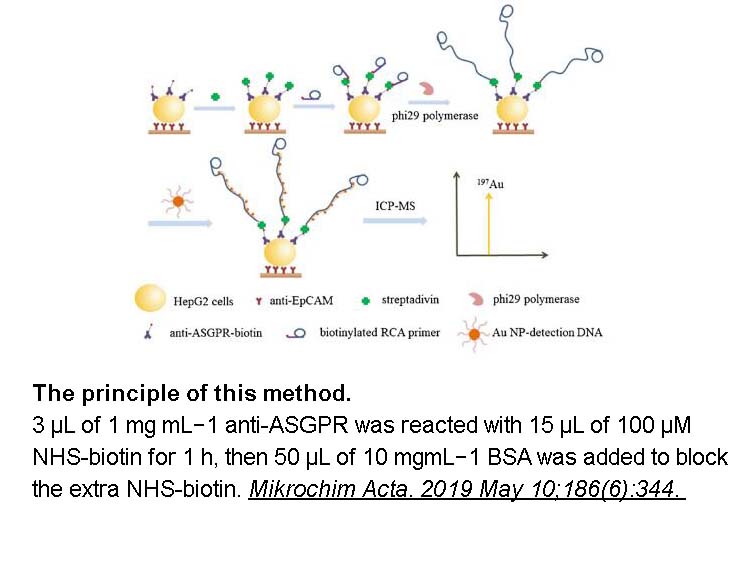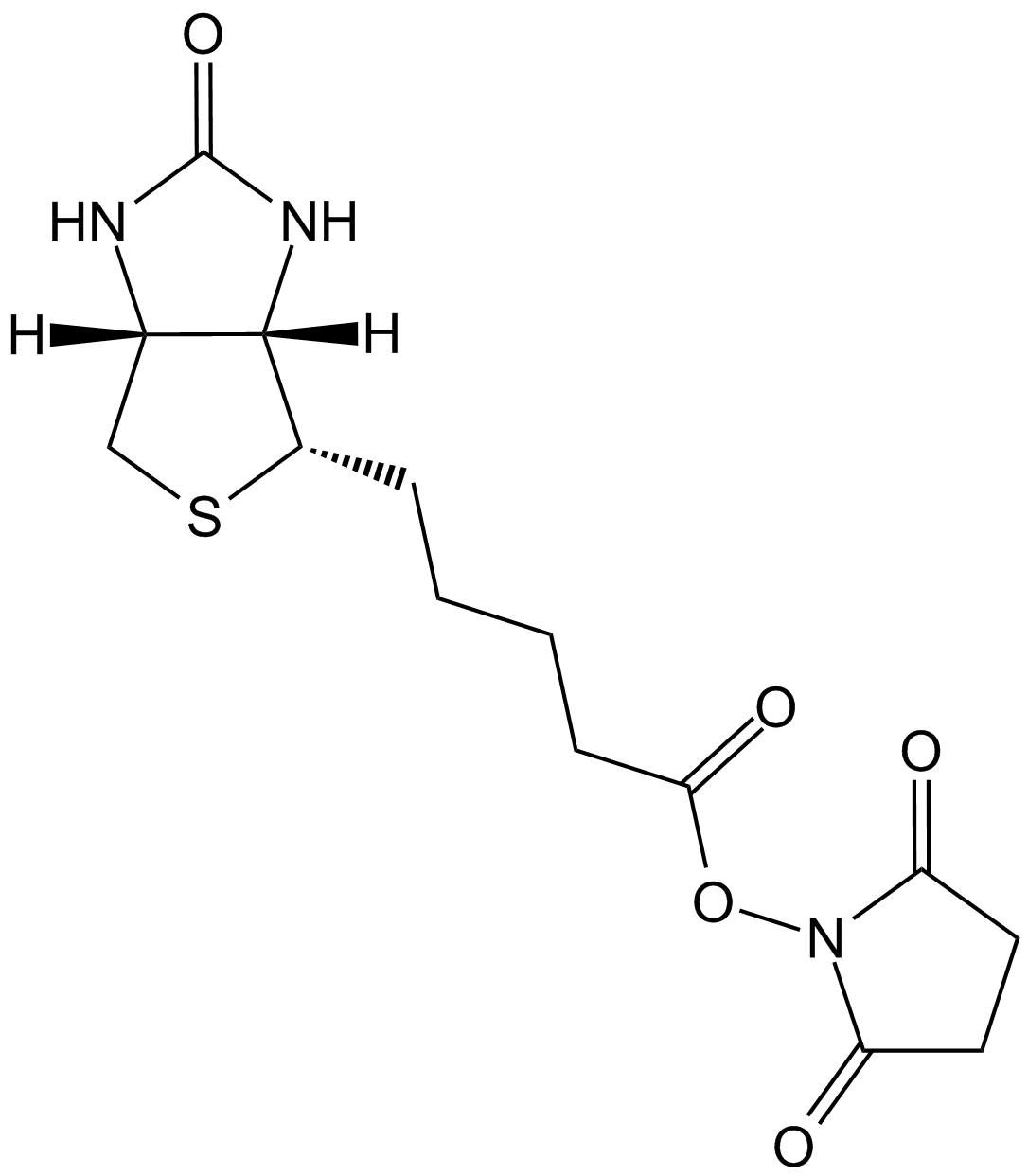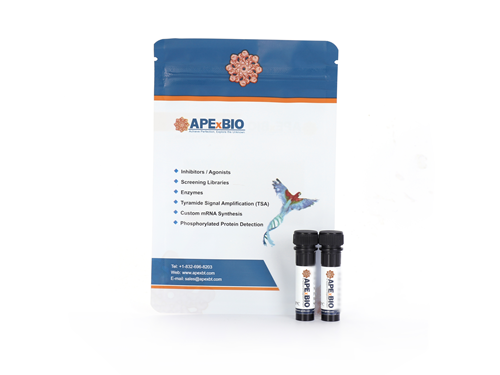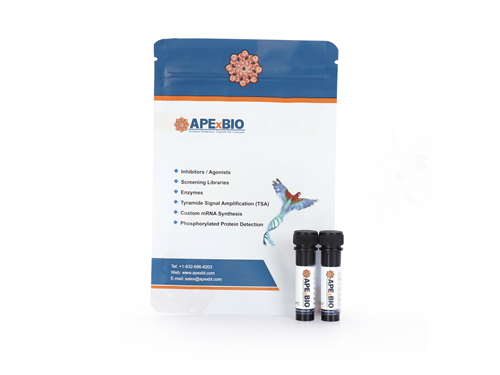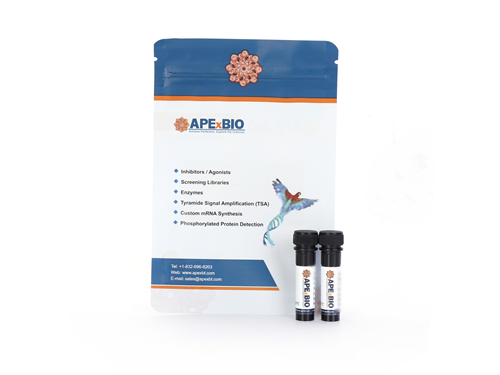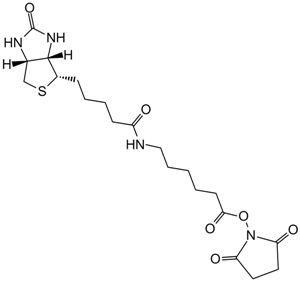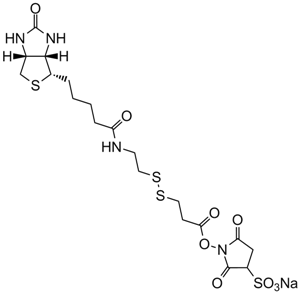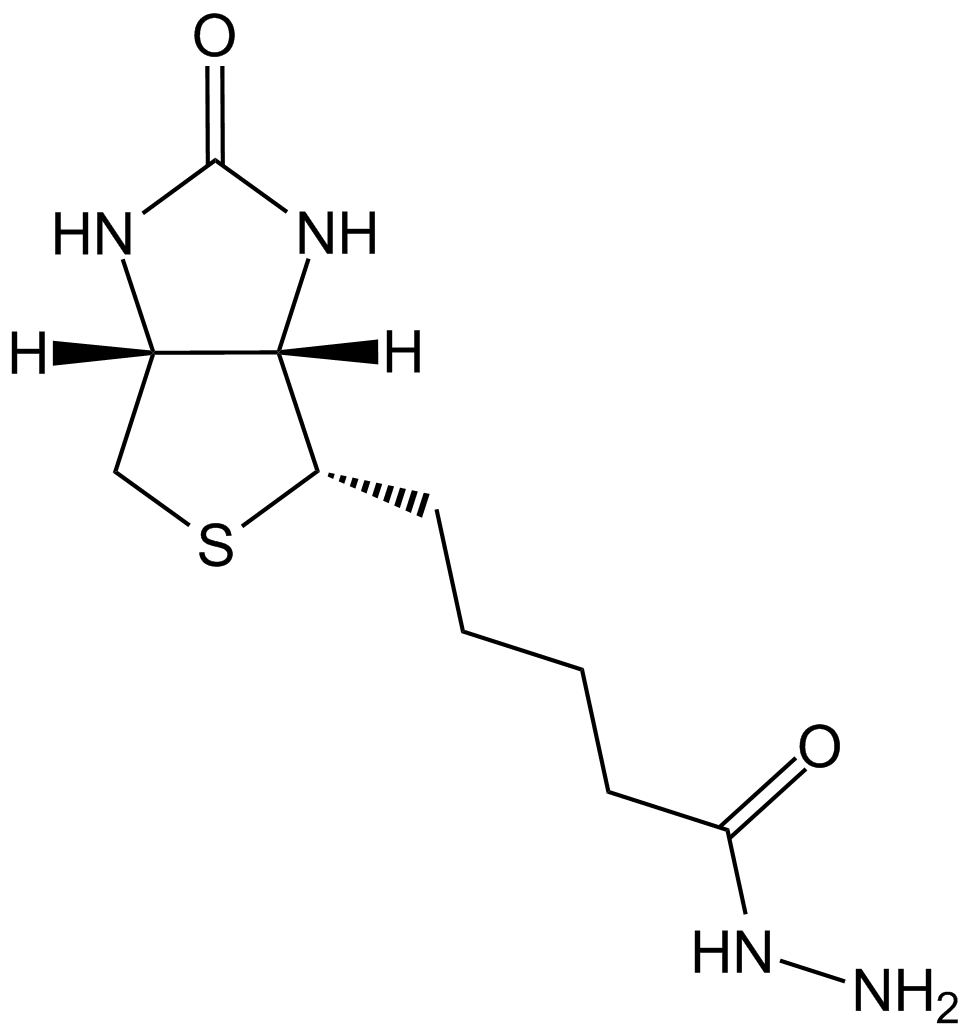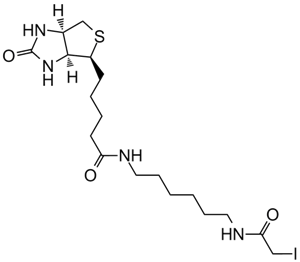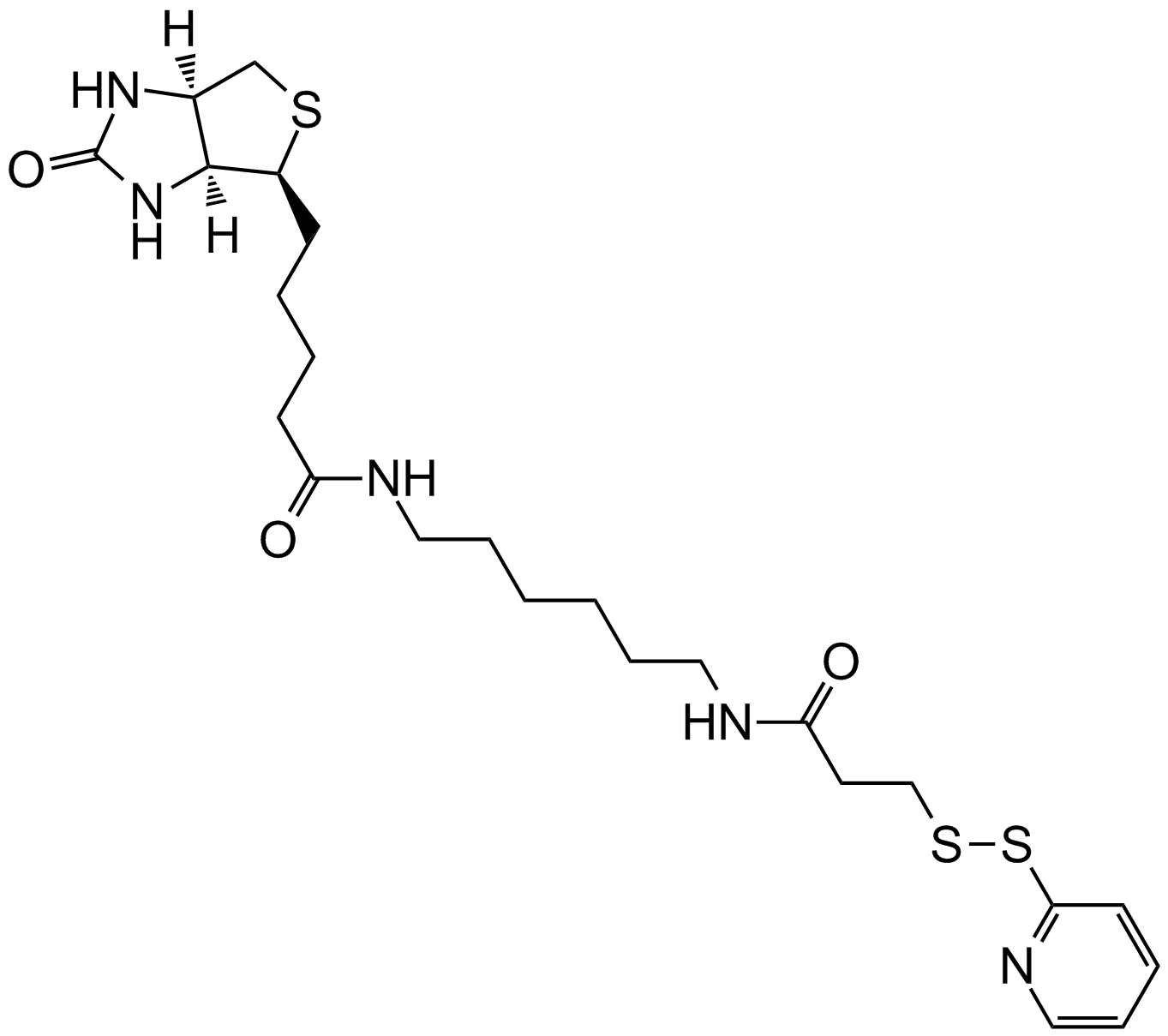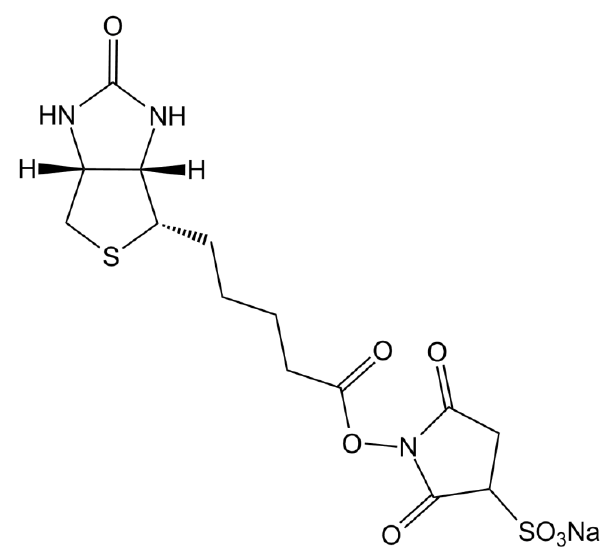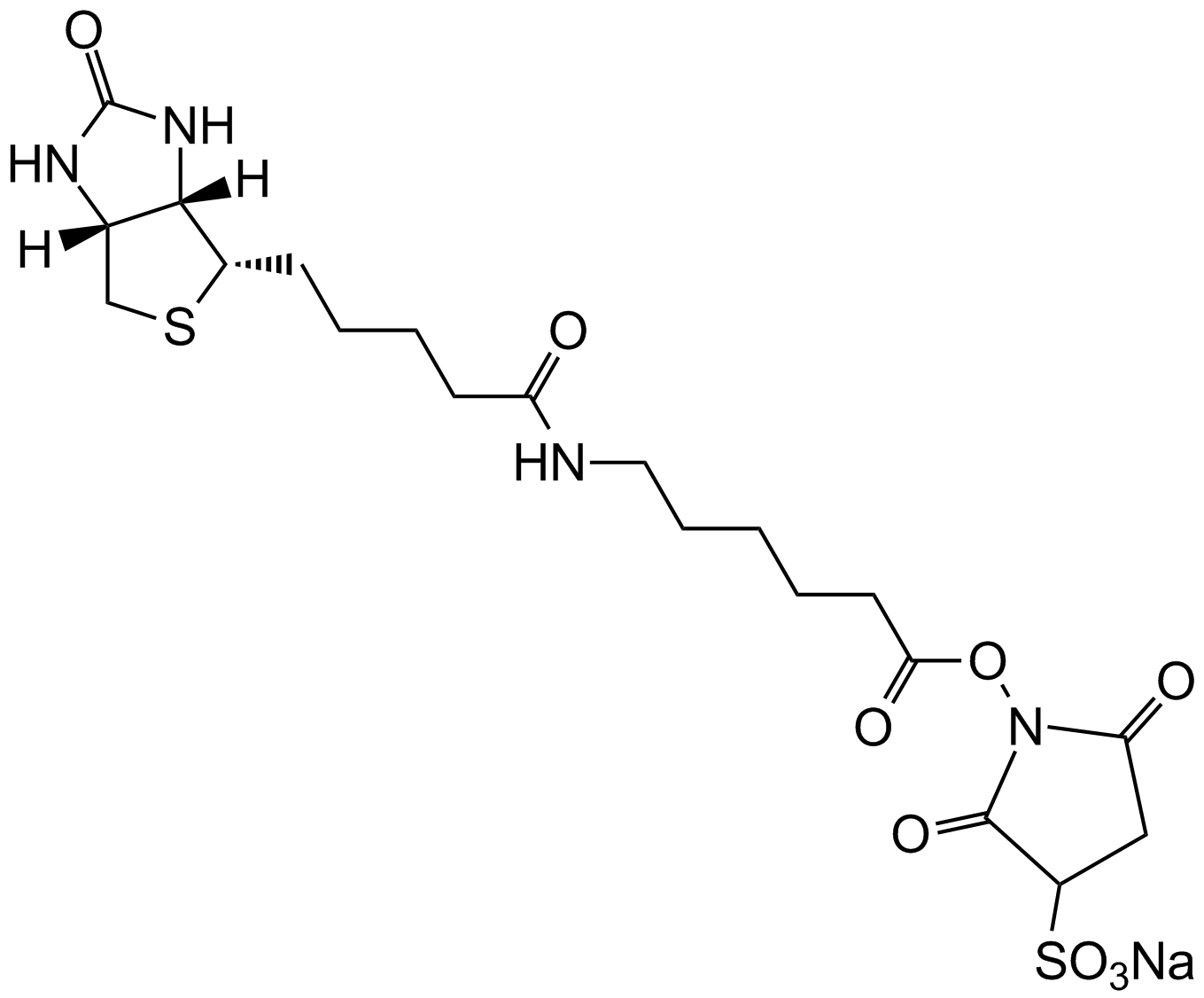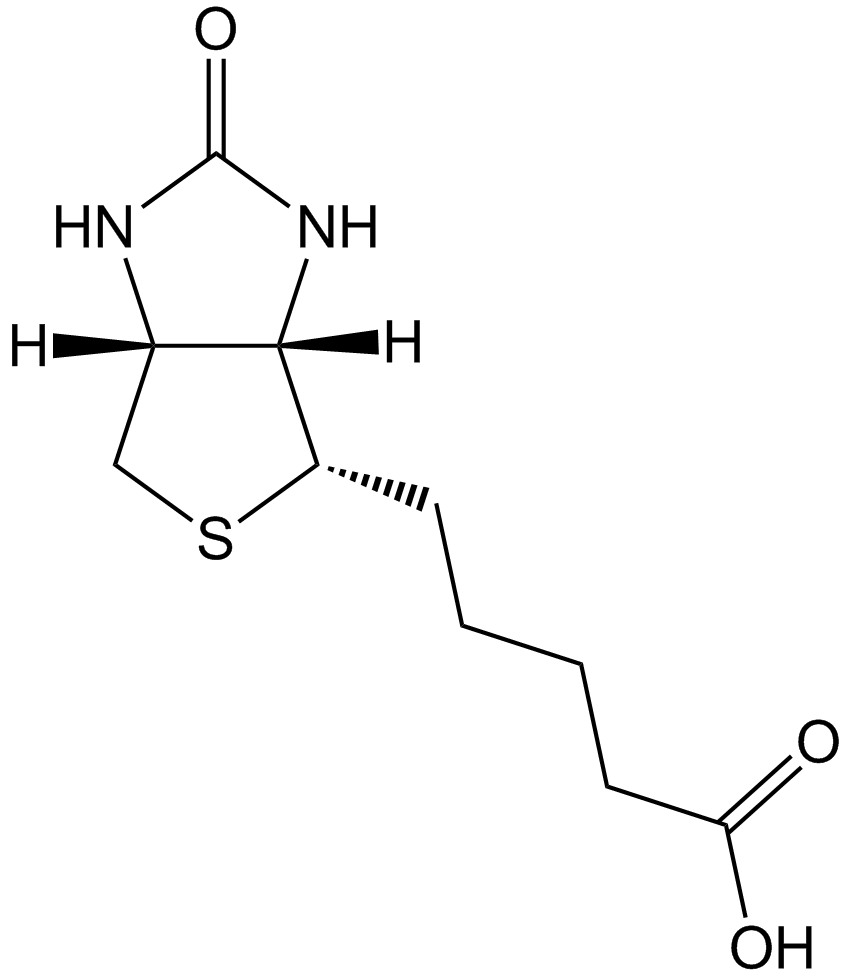NHS-Biotin
NHS-Biotin (C14H18O5N3S) is N-hydroxysuccinimido biotin. It is the shortest of three similar EZ-Link NHS-Biotin Reagents that enable simple and efficient biotinylation of antibodies, proteins and any other primary amine-containing biomolecules in solution. NHS-Biotin offers researchers the possibility of optimizing labeling and detection experiments where steric hindrance of biotin binding is an important factor. Because it is uncharged and contain simple alkyl-chain spacer arms, NHS-Biotin compound is membrane-permeable and useful for intracellular labeling.
NHS-Biotin is the most popular type of biotinylation reagent. NHS-activated biotins react efficiently with primary amino groups (-NH2) in alkaline buffers to form stable amide bonds. Proteins (e.g., antibodies) typically have several primary amines that are available as targets for labeling, including the side chain of lysine (K) residues and the N-terminus of each polypeptide.
Ref:
- Fouassier, L., Yun, C. C., Fitz, J. G. and Doctor, R. B. (2000). Evidence for Ezrin-Radixin-Moesin-binding Phosphoprotein 50 (EBP50) Self-association through PDZ-PDZ Interactions. J. Biol. Chem. 275, 25039-25045.
- Nunomura, W., Takakuwa, Y., Parra, M., Conboy, J.G., & Mohandas, N. (2000) Regulation of protein 4.1R, p55 and glycophorin C ternary complex in human erythrocyte membrane. J. Biol. Chem. 275(32): 24540-24546.
- Chiu, N.H. & T.K. Christopoulos. 1999. Two-site expression immunoassay using a firefly luciferase-coding DNA label. Clin. Chem. 45: 1954–1959..
- 1. Yilun Chen, Franck Duong van Hoa, et al. "Peptidisc-Assisted Hydrophobic Clustering Toward the Production of Multimeric and Multispecific Nanobody Proteins." Biochemistry. 2025 Feb 4;64(3):655-665. PMID: 39810388
- 2. Chen, Yilun, et al. "In vitro production of multimeric and multispecific nanobodies with the peptidisc technology." Biochemistry and Molecular Biology. 2024-11
- 3. Haorong Li , Noah Smeriglio, et al. "Benchmarking and Automating the Biotinylation Proteomics Workflow." Res Sq. 2024 Jul 3:rs.3.rs-4590410. PMID: 39011118
- 4. Liujiao Bian, et al. "Molecular recognition and binding between human plasminogen Kringle 5 and α-chain of human complement component C3b by frontal chromatography and dynamics simulation." J Chromatogr A. 2024 Mar 15:1718:464673. PMID: 38340457
- 5. Vince W Kelly, Shannon J Sirk. "Short FcRn-Binding Peptides Enable Salvage and Transcytosis of scFv Antibody Fragments." ACS Chem Biol. 2022 Feb 18;17(2):404-413. PMID: 35050570
- 6. Yen, Ryan. "Identification of new predictive biomarkers and characterization of molecular mechanisms of drug-resistance in chronic myeloid leukemia." University of British Columbia. 2022.
- 7. Haorong Li, Ashley M Frankenfield, et al. "Thiol-Cleavable Biotin for Chemical and Enzymatic Biotinylation and Its Application to Mitochondrial TurboID Proteomics." J Am Soc Mass Spectrom. 2021 Sep 1;32(9):2358-2365. PMID: 33909971
- 8. JLi X, Chen B, et al. "Immunodetection and counting of circulating tumor cells (HepG2) by combining gold nanoparticle labeling, rolling circle amplification and ICP-MS detection of gold." Mikrochim Acta. 2019 May 10;186(6):344. PMID: 31076917
- 9. Lunin AV, Kolychev EL, et al. "Synthesis of highly-specific stable nanocrystalline goethite-like hydrous ferric oxide nanoparticles for biomedical applications by simple precipitation method." J Colloid Interface Sci. 2019 Apr 1;541:143-149. PMID: 30685609
- 10. Wang P, Tseng KF, et al. "The Central Stalk Determines the Motility of Mitotic Kinesin-14 Homodimers." Curr Biol. 2018 Jul 23;28(14):2302-2308.e3. PMID: 30017487
- 11. Khan M, Schuster S, Zharnikov M. "Chemical derivatization and biofunctionalization of hydrogel nanomembranes for potential biomedical and biosensor applications." Phys Chem Chem Phys. 2016 Apr 28;18(17):12035-42. PMID: 27067511
- 12. Michael J. Bond,Avijeet S. Chopra,et al. "Characterization and Target Identification of AK301: A Novel Mitotic Arrest Agent." University of Connecticut.2016 4 29.
- 13. Tomlinson, J. E., et al. "Survival Time of Cross‐Match Incompatible Red Blood Cells in Adult Horses." Journal of Veterinary Internal Medicine (2015). PMID: 26478135
• Protein labeling—biotinylate antibodies or other proteins for detection or purification using streptavidin probes or resins
• Intracellular labeling—membrane-permeable, can be used to label inside cells
• Amine-reactive—reacts with primary amines (-NH2), such as the side-chain of lysines (K) or the N-terminal-amine
• Irreversible—forms permanent amide bonds; spacer arm cannot be cleaved
• Solubility—water insoluble, must be dissolved in DMSO or DMF before further dilution in aqueous buffers
• Very short—spacer arm is 13.5 angstroms; it consists of the native biotin valeric acid group only
| Physical Appearance | A solid |
| Storage | Desiccate at -20°C |
| M.Wt | 341.38 |
| Cas No. | 35013-72-0 |
| Formula | C14H19N3SO5 |
| Synonyms | Biotin N-hydroxysuccinimide ester, Biotin-OSU, Biotin NHS, Biotin SE |
| Solubility | insoluble in EtOH; insoluble in H2O; ≥17.07 mg/mL in DMSO |
| Chemical Name | (2,5-dioxopyrrolidin-1-yl) 5-[(3aS,4S,6aR)-2-oxo-1,3,3a,4,6,6a-hexahydrothieno[3,4-d]imidazol-4-yl]pentanoate |
| SDF | Download SDF |
| Canonical SMILES | O=C(CCCC[C@@H]([C@H]1N2)SC[C@@H]1NC2=O)ON(C(CC1)=O)C1=O |
| Shipping Condition | Small Molecules with Blue Ice, Modified Nucleotides with Dry Ice. |
| General tips | We do not recommend long-term storage for the solution, please use it up soon. |
| Biotinylation method [1]: | |
|
Sample |
whole blood |
|
Preparation method |
Soluble in DMSO or DMF. |
|
Reaction Conditions |
30 minutes |
|
Applications |
Firstly, NHS-biotin was dissolved in DMSO at a concentration of 100 mg/mL, after that using 90% DMSO solution diluted the biotin to a concentration of 20 mg/mL. The biotin solution was sterilized by filtering the solution through 0.2 μm pore nylon syringe filters and the solution was diluted with 6 volumes 0.9% saline solution. Blood was allowed to warm to room temperature prior to labeling with NHS-biotin. To achieve a biotin concentration of 0.04 pg of biotin/RBC(Red Blood Cells), Biotin DMSO saline solution was injected into each blood bag and agitated for 30 minutes. |
|
References: [1]. J.E. Tomlinson, E. Taberner, R.C. Boston, S.D. Owens, and R.D. Nolen-Walston. Survival Time of Cross-Match Incompatible Red Blood Cells in Adult Horses. J Vet Intern Med 2015;29:1683–1688. |
|
| Description | NHS-Biotin is the simplest NHS-ester activated biotinylation reagent used for intracellular labeling. | |||||
| Targets | intracellular proteins | |||||
| IC50 | ||||||
Quality Control & MSDS
- View current batch:
Chemical structure

Related Biological Data

Related Biological Data

Related Biological Data
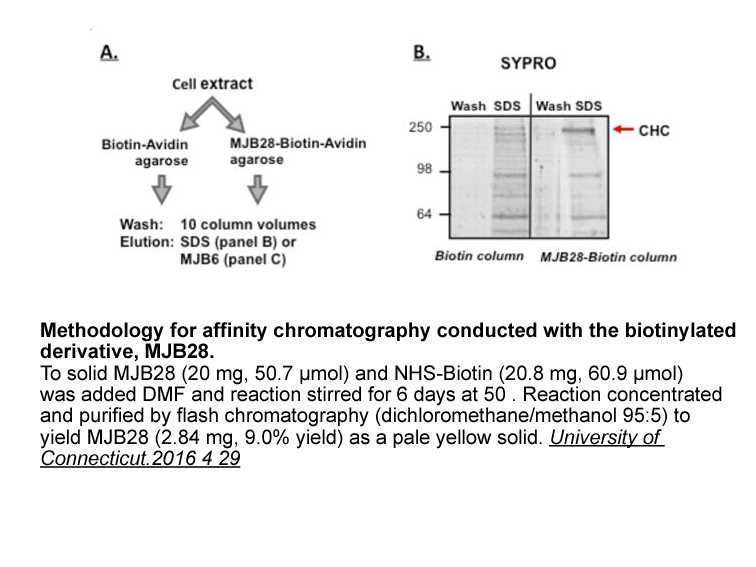
Related Biological Data

Related Biological Data
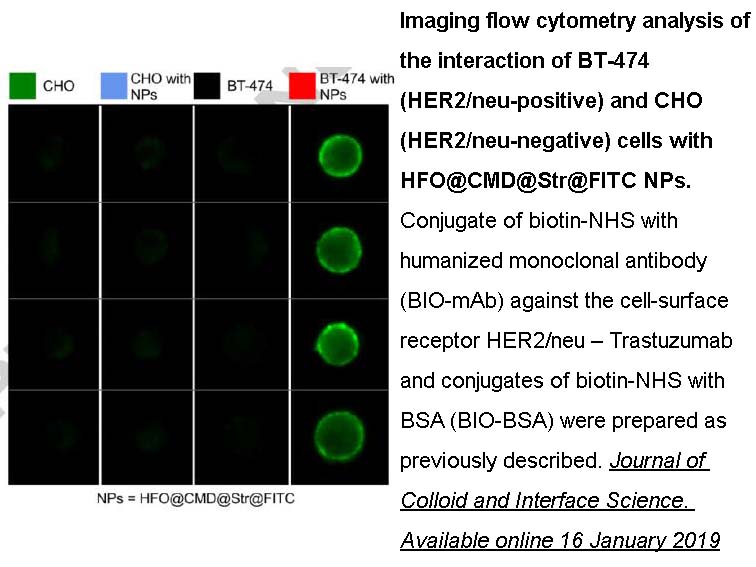
Related Biological Data
